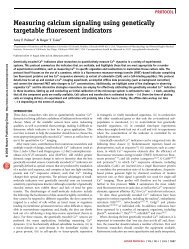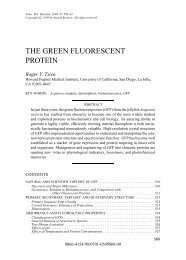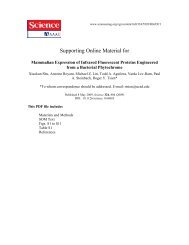Autofluorescent Proteins with Excitation in the Optical ... - Tsien
Autofluorescent Proteins with Excitation in the Optical ... - Tsien
Autofluorescent Proteins with Excitation in the Optical ... - Tsien
You also want an ePaper? Increase the reach of your titles
YUMPU automatically turns print PDFs into web optimized ePapers that Google loves.
Figure 2. Performance of Neptune <strong>in</strong> Cells and Animals<br />
(A) Design of a monocistronic adenovirus vector for coexpression of GFP and Neptune (Ad-Neptune) or (Ad-mKate) <strong>in</strong> hepatocytes.<br />
(B) Sections of liver were removed from a mouse <strong>in</strong>jected <strong>with</strong> Ad-Neptune or Ad-mKate and imaged at red or far-red wavelengths on a confocal microscope. GFP<br />
was also imaged to confirm expression of <strong>the</strong> cistron. Fluorescence <strong>in</strong>tensities are shown <strong>in</strong> <strong>the</strong> chart. Scale bar, 50 mm.<br />
(C) Epifluorescence of Neptune <strong>in</strong> <strong>the</strong> liver of a liv<strong>in</strong>g mouse acquired on a Maestro imag<strong>in</strong>g system <strong>with</strong> excitation and emission at 610–630 nm and 660–700 nm,<br />
respectively. Scale bar, 5 mm.<br />
(D) Dual fluorescence imag<strong>in</strong>g <strong>in</strong> <strong>the</strong> optical w<strong>in</strong>dow is possible <strong>with</strong> Neptune and <strong>in</strong>frared fluorescent prote<strong>in</strong>. Images of live mice express<strong>in</strong>g Neptune or IFP1.1 <strong>in</strong><br />
liver were acquired <strong>with</strong> Cy5 and Cy5.5 channels. <strong>Excitation</strong>/emission wavelengths used were 610–630/660–700 nm for Cy5 and 625–675/700–730 nm for Cy5.5.<br />
In <strong>the</strong> right column, spectral unmix<strong>in</strong>g was used to correct for Neptune cross-excitation and -detection <strong>in</strong> <strong>the</strong> Cy5.5 channel. Restrict<strong>in</strong>g <strong>in</strong>frared fluorescent<br />
prote<strong>in</strong> excitation to above 650 nm <strong>with</strong> custom filters would produce similar results.<br />
emission) and Cy5.5 (<strong>in</strong>frared emission), respectively. Indeed<br />
liver-expressed Neptune was selectively imaged <strong>in</strong> <strong>the</strong> Cy5<br />
channel while IFP1.1 was preferentially imaged <strong>in</strong> <strong>the</strong> Cy5.5<br />
channel (Figure 2D). A small amount of cross-detection of<br />
Neptune occurred us<strong>in</strong>g our Cy5.5 excitation filter due to its<br />
broad excitation range (625–675 nm). This signal can be subtracted<br />
by l<strong>in</strong>ear unmix<strong>in</strong>g (Figure 2D) or preferably elim<strong>in</strong>ated<br />
by <strong>the</strong> future design of an appropriately narrow excitation filter<br />
for IFP1.1. We also confirmed that excitation wavelengths <strong>in</strong><br />
<strong>the</strong> optical w<strong>in</strong>dow detected liver fluorescence more efficiently<br />
than shorter wavelengths for both Neptune and its parent mKate<br />
(Figure S3 and Table S2).<br />
1172 Chemistry & Biology 16, 1169–1179, November 25, 2009 ª2009 Elsevier Ltd All rights reserved<br />
Chemistry & Biology<br />
Fluorescent <strong>Prote<strong>in</strong>s</strong> <strong>with</strong> Far-Red <strong>Excitation</strong><br />
Quaternary Structure of Neptune and Fur<strong>the</strong>r<br />
Monomerization<br />
We studied <strong>the</strong> quaternary structure of Neptune, mKate, and<br />
mKate derivatives <strong>in</strong> solution by size-exclusion chromatography<br />
<strong>with</strong> <strong>in</strong>-l<strong>in</strong>e multiangle laser light scatter<strong>in</strong>g. At low micromolar<br />
concentrations, Neptune and mKate (Figure 3A), as well as mKate<br />
S158A and mKate S158C (Figure S4A), primarily comigrate <strong>with</strong><br />
<strong>the</strong> dimeric standard dTomato. However, <strong>the</strong> elution profiles<br />
are not monodisperse, but ra<strong>the</strong>r exhibit a trail<strong>in</strong>g tail that overlaps<br />
<strong>with</strong> <strong>the</strong> elution profile of <strong>the</strong> monomeric standard mCherry.<br />
In contrast, mGrape3, EGFP, and mCherry all comigrate <strong>in</strong> a sharp<br />
monodisperse peak (Figure S4A). Light scatter<strong>in</strong>g reveals






